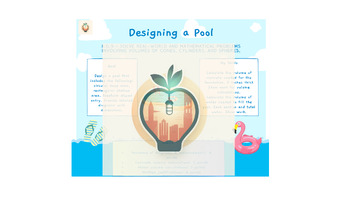Designing a Pool 8.G.9 Problem Based Learning volume of 3D shapes
- Google Docs™

Description
Bring math to life and spark students' creativity with the Treehouse Project-Based Learning activity! This hands-on and engaging project enables students to apply their knowledge of 3D shapes and volume calculations in a fun, practical context - designing their dream pool.
Students will sketch their pool designs, calculate volumes of various components, and explain their mathematical thinking. This activity promotes critical thinking, problem-solving, collaboration, and communication skills.
The detailed project outline, requirements, and grading rubric provide flexibility for teachers to tailor the activity to their curriculum and students' needs. Whether used for review and assessment or as an immersive learning experience, the Pool Project adds an interactive element to math instruction.
8.G.9


